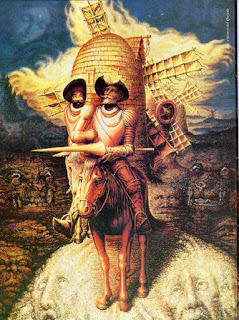Dialogue work has opened a similar fascination for me: puzzling together how we see and experience life so differently; talking to friends and noticing that we may have attended the same event, movie or meeting and come away with unique conclusions. Don't you find that curious?
Darcy (a Dialogue partner and friend) and I were talking recently about experiences with our dialogue practices. She commented about times when people would see something one way and realize later on that there may have been other meanings present but not seen. Do you wonder why others cannot see what you see?
For instance, look at this photo: what do you see?
 |
| What do you see? (Click on photo to enlarge it.) (Image from BrainDen.com) |
Another photo I saw years ago and rediscovered when searching the internet is Octavio Ocampo's painting of Don Quixote. A broad view of the painting reveals a portrait of Don Quixote. Once one is drawn into the painting, though, more images can be seen: the windmill, a horse, Sancho Panza, plus many other objects and faces. (How many faces do you see?) It is as if the whole Cervantes story is being recreated in this painting.
 |
| I see... Don Quixote, by Octavio Ocampo (Image from BrainDen.com) |
But, some days it seems that I -- or others -- have so much to say! Our stories spill over! When I do slow down and listen, I find that curiosity begins to take root: I wait for those valuable nuggets of truth that are waiting to be shared, and I hear so much more than when we were racing through our stories.
The self-illusion -- or possibly, self-delusion -- is the notion that I can take in and understand all of life's lessons! Like the Ocampo painting, maybe it requires us to learn a dialogue discipline of... waiting... seeking one image at a time... and waiting some more! (Such a difficult concept in this fast-paced world!)
Just like there are optical illusions which trick us into seeing one image over another, I wonder, without slowing down and waiting, if we tend to favor one perspective over others?
Are you ready for another image? What do you see? (Type what you see in this blog's 'Comments.')
 |
| Coffee beans and...? (Image from BrainDen.com) |
- Offer what we see, and listen for another perspective;
- Hold gently to what is similar and different;
- Wait for the unexpected to reveal itself; and
- Humbly accept that all views may be valid and real.
Questions to consider this week when interacting with loved ones, friends, and colleagues:
- What do I see or hear first?
- Am I willing to listen for other perspectives?
- Can I see the truth in all views?
- Will I hold gently myself and others when we cannot see or understand?
May we be open to seeing beyond our first impressions!
 |
| Larry Gardepie Dialogue San Diego Consulting |
I am reminded how sometimes I need to slowdown to connect with what is behind what I’m experiencing in the moment, I usually think it’s one thing and after careful consideration I find other deeper more concrete experiences; many times these are easier for me to share and for others to understand once I distill everything to the core issues...
ReplyDelete